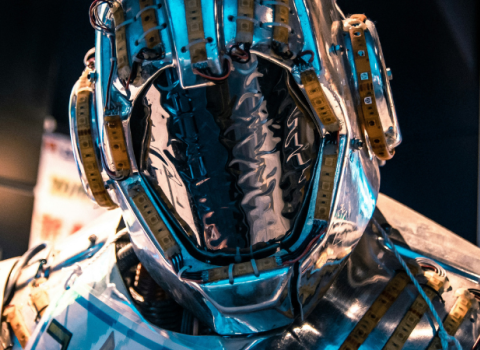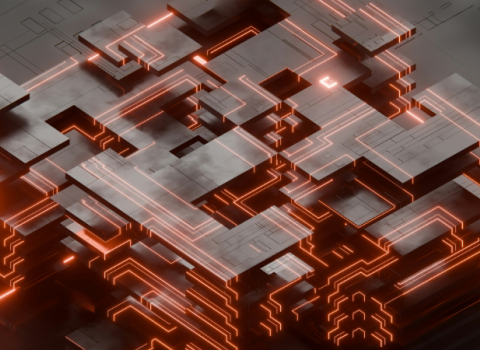
Credit: NIST
Scientists love to complicate things; and if you're not in the same field, or - worse - are in business or investment - it's easy to get lost. So periodically, Science|Business presents Quick Guides to some of the hottest fields of science and technology.
Spintronics is one of the hottest new fields in physics. It takes electronics down to the quantum level, where what matters is the behaviour of individual atoms and electrons rather than of groups of them. The science involves the spin of electrons and hence their magnetic fields. Early applications could be in the development of new memory technologies that can store data at much higher densities.
What is it? |The technology | Any money in this? | Market intelligence |Where's the buzz? | Some key papers
Electrons don't just carry charge, the property that gives us electronics and electricity, they also disport spin. It is not that you will catch an electron whirling on its axis, more a case of finding it in a state of 'upness' or 'downness'.
The idea of spintronics, spin-based electronics, is to exploit the electron's charge and spin. It is a part of the move of electronics down to the quantum level. Where the behaviour of individual atoms and electrons gets to be more important than their behaviour en masse.
If you can detect when an electron is up or down, you are on your way to using that information. Computing, after all, builds on the ability to detect binary on/off states to store and manipulate all those 0s and 1s.
Electron spin is tied up with magnetism, another physical phenomenon much used in computing, in data storage, for example. You get magnetism when electron spin lines up.
Early interest in electron spin, in the 1980s, was in a phenomenon known as giant magnetoresistance (GMR).
The technology
What will it do? Data storage is one of the first likely uses of spintronics. The idea is that electron spin will add up to quicker and more densely packed data storage.
You can already see the fruits of electron spin in GMR - it is behind the read/write heads in today's hard disks
After that, maybe we could devise semiconductor materials that manipulate the spin of electrons just as we now mess around with their charge. Thus could be born a new approach to electronics, and one that could smash the physical barriers that limit what we do with charge based semiconductor devices.
Electronics has done wonders of miniaturisation in the 50 years or so since the first transistor - so why bother? Because there are physical limits to Moore's Law, the self-fulfilling prophesy that we can double the number of chips on a piece of semiconductor real estate every 18 months or so.
Academics are also working themselves up into a frenzy about something called quantum computing. That would smash Moore's Law, and might need spintronics to happen.
Trouble is, spintronics could need a whole new bunch of electronics materials. It is a long-haul venture.
Any money in this?
"Spintronics has a number of potentially groundbreaking applications that are set to drive next-generation electronics." That's what the analysts say at market-research firm Frost & Sullivan. "While GMR can arguably be considered the driving force for spintronics at present, the biggest potential of spin-based devices is in embedded memories." It is known as MRAM, magnetoresistive random access memory.
Then there is the general hysteria surrounding nanotechnology. Being really really small, spintronics rides that bandwagon too.
There is certainly plenty of R&D cash going into spintronics, with more than a dozen active labs in the USA alone. Some of the bigger companies, such as IBM, are players too.
There are even some start-ups in the spin space. Indeed, one, NVE Corporation, has been around since 1989, is quoted in NASDAQ, and describes itself as "a leader in the practical commercialization of spintronics, a nanotechnology that many experts believe represents the next generation of microelectronics". NVE licenses its technology. Agilent is one customer.
Market intelligence
With few clear products out there, or even in the lab, there isn't much in the way of detailed market research. Look no further than the billions dollars that go into memory for some clues to the potential. One report gives some ideas when its says that "we expect MRAM to generate $12.9 billion in revenues by 2011". That is just one area where spintronics shows potential, and don't forget that GMR is already big in hard disks, another billion dollar market.
Where's the buzz?
Most of the big name universities have their spintronics teams.
In April 2004, scientists at IBM's Almaden Research Center and Stanford University formed the IBM-Stanford Spintronic Science and Application Center for the advanced research and creation of new, high-performance, low-power electronics.
At the beginning of 2005 a team at the Albany NanoTech College of Nanoscale Science and Engineering in New York State managed to get silicon, the workhorse of the electronic chip industry, to do spintronic things.
In June another team from the University of California working at Los Alamos National Laboratory persuaded gallium arsenide, a semiconductor material behind some of the functions in mobile phones, to do spin things.
They have their own spintronics doctors at IMEC, the Interuniversity MicroElectronics Center, at Leuven in Belgium. IMEC, one of Europe's leading research labs in electronics, has more than a decade's experience in spin. They also play with gallium arsenide among other semiconductors.
A group at Oxford University is also a player. So much so that the university's commercialisation arm, Isis, is looking for someone to license their work for computer memory.
One indicator of how 'hot' the subject is comes from the citations of papers. Spintronics was the subject of one of the top three papers in physics over the past couple of years: "Spintronics: A Spin-Based Electronics Vision For The Future". It appeared in the journal Science on 16 November 2001. In citation speak that's Science, volume 294, issue 5546, page 1488-1495.
Some key papers
One of the most cited papers in physics, let alone spintronics, appeared in the journal Science five years ago. It lays the foundations for the subject and describes some of the possible advantages that spintronics bring to microelectronics. As the abstract puts it: "Either adding the spin degree of freedom to conventional charge-based electronic devices or using the spin alone has the potential advantages of nonvolatility, increased data processing speed, decreased electric power consumption, and increased integration densities compared with conventional semiconductor devices."
Science, 16 November 2001, vol. 294, pp 1488-1495.
The same journal has just added another major paper to the collection. This time "spintronics" does not appear in the title "Magnetic Domain-Wall Logic". The introduction is more forthcoming: "'Spintronics,' in which both the spin and charge of electrons are used for logic and memory operations, promises an alternate route to traditional semiconductor electronics." This paper reports on research that has made spintronic versions of some of the basic building blocks of electronics.
Science, September 2005, vol. 309, pp 1688-1692.





 A unique international forum for public research organisations and companies to connect their external engagement with strategic interests around their R&D system.
A unique international forum for public research organisations and companies to connect their external engagement with strategic interests around their R&D system.